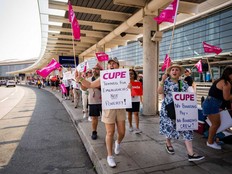Dear Mayor: How cool is your city?

Article content
Reviews and recommendations are unbiased and products are independently selected. Postmedia may earn an affiliate commission from purchases made through links on this page.
We owe it to ourselves to lobby our civic leaders to come up with actionable heat mitigation strategies
Dear mayor (and members of council), have you ever thought about how cool your city is?
Recommended Videos
If things are heating up in your city the way they are across Canada right now, you’re not alone.
Times of extreme heat have become our new normal. So what are you going to do for the people living in your town to address this challenge?
These are questions we should be asking local politicians everywhere, whether you live in Toronto, Timmins or anywhere else in this vast country.
Because regardless of our northern latitude, coping with extreme heat in our cities has become one of the biggest challenges we face as a result of global warming.
Sadly the most vulnerable members of our population are often the most affected by heat waves and heat domes (the latter covering a bigger area and without a temperature drop at night). These are people who often live without air conditioning and rely on a combination of walking, biking and public transit to go to work or do household errands.
For these people and the population in general, we owe it to ourselves to lobby our civic leaders to come up with actionable heat mitigation strategies which have both short and long-term perspectives. Here’s just four suggestions for your local leaders to consider to make where you live cooler place to be.
One. Embrace a ‘water water everywhere mindset’ to keep residents hydrated. Our natural response to extreme heat is to sweat, which in turn can lead to dehydration, higher body temperatures and potential health issues. With that in mind, it’s important our urban leaders make access to water in public spaces a priority.
This is precisely what they’ve done in Vancouver, where in addition to its permanent locations, each summer the city sets up temporary drinking fountains and water bottle filling stations strategically located throughout the city.
Similarly, some cities including Ottawa, Lethbridge and Waterloo have launched hydrant drinking fountain programs, whereby conventional fire hydrants are temporarily converted into bottle filling stations as a way to beat the heat.
Meanwhile, learning from a similar program initiated by the City of Guelph, for public events Toronto has set up what’s known as an H2O to Go program in which water trailers outfitted with 10 drinking taps and 10 water filling stations are installed to help keep people hydrated.
Two. Create temporary cooling stations. I remember years ago when participating in an August run in Quebec City, how the coolest thing on that scorcher of a day, was the water misting stations they had along the route.
For a few years now, complimenting its portable drinking stations, Vancouver also has temporary misting stations where locals can go to cool off. Just this year, Toronto’s Catholic School system followed suit, placing misting stations at schools as a temporary solution to help kids cool down during the hotter days.
Three. Create permanent cooling stations. Not every neighbourhood boasts public infrastructure designed specifically to help residents cool off, whether it’s a cooling station, a sprinkler system a wading pool or in a best-case scenario a swimming pool, but they should.
One way to do that is for our community leaders to identify and map out where the hottest areas of the city are and cross reference that with where cooling stations need to be set up if they don’t already exist.
Four. Go from grey to green. Every year on the third Friday of each September, cities around the world participate in an initiative know as Park(ing) Day whereby parking lots are transformed into temporary parks and public spaces. Unlike actual parking lots, these spaces really are cool places to hang out thanks to such measures as installing temporary grassy areas, bringing in shade trees and adding benches or chairs so that passersby can sit down.
The unique thing about this initiative is that it helps to demonstrate how, with a bit of imagination, our community leaders can identify locations within their cities where more parks or parkettes are needed, places that offer shade from trees or covered areas or both.
These are just a few action items for our local leaders to consider, as the starting point to make your town a cooler place to live.
Mark Wessel lives in Ridgeway, Ont. and is a passionate advocate for living more sustainably at home and in the greater community. Visit www.markdouglaswessel.com.











Postmedia is committed to maintaining a lively but civil forum for discussion. Please keep comments relevant and respectful. Comments may take up to an hour to appear on the site. You will receive an email if there is a reply to your comment, an update to a thread you follow or if a user you follow comments. Visit our Community Guidelines for more information.